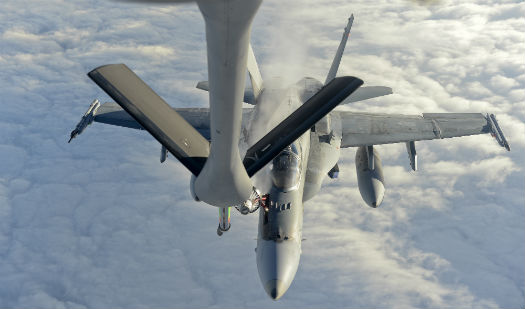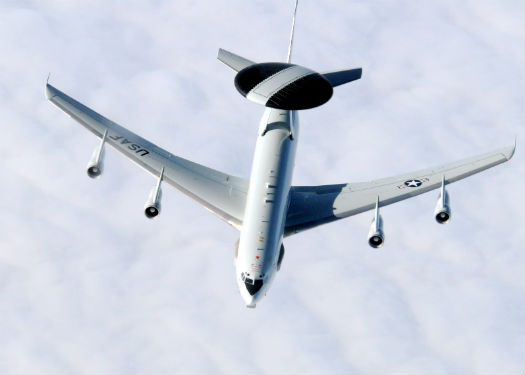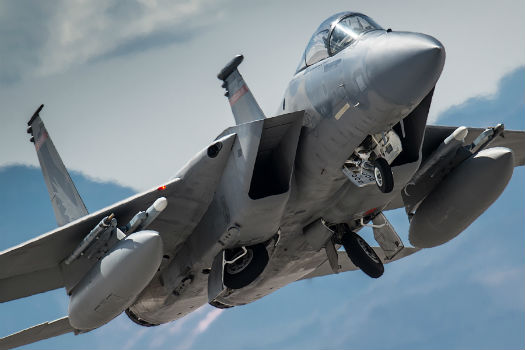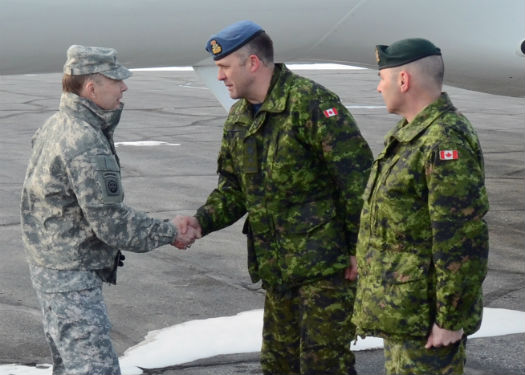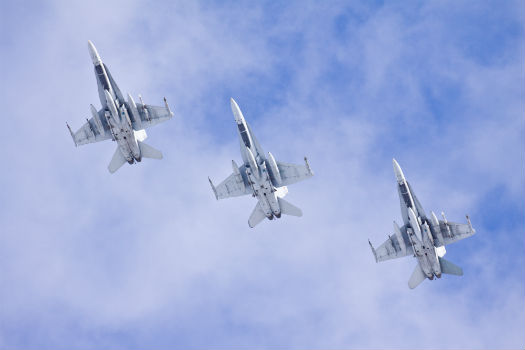In 1958, Canada and the U.S. signed an agreement to create a bi-national structure that would centralize efforts to defend North American airspace. The result, NORAD, is unlike any other agreement in the world. Both countries contribute assets to ensure their mutual defence. In this case a USAF KC-135R tanker tanker refuels a CF-18 during the NORAD exercise Vigilant Shield in October this year. USAF Photo
If you’ve watched action, drama or even science fiction movies and TV shows over the past 50 years, chances are pretty good that you’ve at least heard of NORAD, the North American Aerospace Defense Command. Often, it’s depicted as a massive operations room with radar screens, uniformed personnel manning various stations and star-studded generals directing all the action. Every Christmas Eve, it’s the means by which millions of children get regular reports on Santa’s progress as he journeys around the world.
Outside of pop culture, however, NORAD is a real military entity. But what is it, and what do we really know about it? More importantly for Canadians, what impact does it have on Canada?
While NORAD is often depicted in film and television as an American entity, it is in fact a joint U.S.-Canadian defence partnership charged with aerospace warning and control for both countries. What this means is that NORAD detects and advises both governments about airborne threats to North America (aerospace warning) and takes action to deter and defend against those threats (aerospace control).
“What it comes down to, essentially, is that Canada and the U.S. have airspace over our respective territories, and we should be in control of who enters it and how they conduct themselves in it,” explained Col Patrick Carpentier, the Canadian deputy commander of the Alaskan NORAD Region.
NORAD’s commander is directly and equally responsible to both the President of the United States and the Prime Minister of Canada. While it’s no secret that Canada and the U.S. enjoy a very close alliance, NORAD is truly unique in the world—no other two countries have an arrangement quite like it.
The partnership grew out of the high tensions with the Soviet Union during the Cold War. Throughout the Second World War, Canada and the U.S. worked closely together, but the advent of nuclear weapons and long-range bombers meant that there was a very real chance that North America could be attacked directly in the event of war. This potential threat was the impetus for a broader level of cooperation between the two countries for mutual defence.
As part of Canada’s contribution to NORAD, RCAF crews are fully integrated into USAF E-3 Sentry operations. 1st Lt Christopher Mesnard Photo
In 1958, both governments signed an agreement to create a bi-national structure that would centralize efforts to defend North American airspace. The agreement established guidelines and principles on how the command would be organized and operated. NORAD would be commanded by an American general, with a Canadian general as deputy commander, who would be equally responsible to both governments. Currently, NORAD is commanded by U.S. Army Gen Charles Jacoby Jr., who is also the commander of U.S. Northern Command (the U.S. joint command responsible for homeland defence), while the NORAD deputy commander is Royal Canadian Air Force (RCAF) LGen Alain Parent.
NORAD’s headquarters and central operations centre is at Peterson Air Force Base in Colo. Springs, Col. It moved there in 2006 from its previous home in the famous Cheyenne Mountain Complex, a base dug into the granite under Cheyenne Mountain, Colo., which provided a hardened underground facility capable of withstanding potential strikes.
NORAD has three main missions, the first of which relates directly to its original raison d’être—detecting and defending against outside airborne threats. During the Cold War, Soviet bombers undertook “strategic aviation”—long-range flights that skirted the airspace of other countries, including Canada and the U.S. Detecting and intercepting these flights was the mainstay of NORAD’s activities for decades, but following the collapse of the Soviet Union, this activity ceased in 1992. In 2007, Russian President Vladimir Putin announced that his country’s military would resume strategic aviation. While military aircraft from Russia or any other country have never entered the sovereign airspace of Canada or the U.S. without permission, NORAD has remained vigilant in detecting and, when necessary, intercepting aircraft approaching North America to ensure they pose no danger.
While NORAD was born under the threat of a foreign military strike, its role changed dramatically following the Sept. 11, 2001, terrorist attacks on the U.S. Up to that point, NORAD’s attention had been focused outwards, watching for a conventional, or “symmetric” military attack. But, with the realization that civilian aircraft could be used as weapons, and the devastating damage they could cause, NORAD began to look inward, within the airspace of North America. To defend against “asymmetric” attacks of this nature, NORAD took on a new standing mission—Operation Noble Eagle (ONE). Under ONE, military aircraft operating under NORAD can intercept any aircraft posing a threat to either Canada or the U.S. and, if necessary, engage it on the orders of either government. Although the need to be prepared for such a possibility is grim in the extreme, it is a reality of the post-9/11 world to which NORAD must be ready to respond.
The third mission set for NORAD is the newest, added in 2006—maritime warning. Like aerospace warning, it involves monitoring vessels transiting to the NORAD area of operations. This is done in conjunction with other agencies in both Canada and the U.S.
NORAD tasks fighter aircraft to respond to potential threats in its airspace. They are sent to intercept, identify, communicate with and, if necessary, engage threats. Stuart Sanders Photo
These three missions may sound straightforward, but fulfilling them over territories as vast as Canada and the U.S. is no mean feat. NORAD divides the labour by separating the airspace of both countries into three regions: the Continental U.S. NORAD Region (CONR), the Alaskan NORAD Region (ANR) and the Canadian NORAD Region (CANR). Each of the regions has its own commander and deputy; in the case of CONR and ANR, the commander is American and the deputy is Canadian, while in CANR, the reverse is true.
CANR’s current commander is RCAF MGen David Wheeler, and its deputy is U.S. Air Force (USAF) BGen Charles Hyde, both of whom are based at 1 Canadian Air Division and Canadian NORAD Region (1 CAD/CANR) headquarters in Winnipeg, Man. As is the case in all the NORAD regions, the commander’s working relationship with this deputy commander is an extension of the larger bi-national partnership.
“NORAD is different from many of the other alliances or coalitions that the Canadian Armed Forces participate in due to the fact that there are only two nations involved,” said Wheeler. Having a close alliance isn’t just good for getting the job done, it’s essential when sharing a responsibility as important as protecting one’s homeland. “We each need to know what the other is thinking about and work together to ensure success in an effective manner.”
Wheeler is also the operational commander for the entire RCAF, overseeing the 12 Wings across Canada and the RCAF’s aircraft fleets, and providing air power and support for all Canadian military operations at home (including search and rescue) and abroad. Without question, he’s a busy man, but he has no doubt whatsoever about the importance of his responsibilities, including CANR.
“Conducting NORAD operations is essentially conducting defence of your home turf,” he said. “When you defend your own nation, there’s always that added emphasis.”
As an entity, NORAD is what is known as a “force employer,” meaning it makes use of people and assets to accomplish a mission. It is not a “force generator,” meaning it doesn’t “own” personnel and equipment. Rather, it draws on the existing capabilities of both Canada and the U.S. to fulfil its mission.
Forward operating locations in Canada’s North are capable of supporting CF-18 Hornet operations. The jets are on alert 24 hours a day, 365 days a year for NORAD missions. Stuart Sanders Photo
In Canada, NORAD looks to the RCAF for support. This is coordinated through the Combined Aerospace Operations Centre (CAOC) at 1 CAD/CANR HQ in Winnipeg, which is the nerve centre of RCAF operations, including NORAD. It resembles the classic operations centre people would recognize from movies, with large screens, maps and people at computer stations, all working together to coordinate operations.
Supporting the CAOC is 22 Wing in North Bay, Ont., which is home to the Canadian Air Defence Sector (CADS). CADS is responsible for the aerospace warning and control missions in CANR, through a combination of civilian and military radar systems, including the North Warning System, a chain of radar installations running along the northern coast of mainland Canada and Alaska. This provides a picture of what is happening in airspace both outside and inside of Canada’s territory. CADS feeds this information to the CAOC in Winnipeg, and acts as the interface with aircraft tasked with NORAD missions.
To respond to potential threats, NORAD draws on aircraft, usually fighter jets, which are sent to intercept, identify, communicate with and, if necessary, engage aerospace threats. In Canada, that task falls to the CF-18 Hornet. Based primarily at 3 Wing Bagotville, Que., and 4 Wing Cold Lake, Alta., the Hornet operates out of bases across Canada, and deploys to CANR’s northern forward operating locations, which are mini bases capable of supporting NORAD operations.
CF-18s are on alert 24 hours a day, 365 days a year in Canada for short-notice response to NORAD missions. Sometimes, this means identifying foreign aircraft approaching North America, as was the case in September 2014 when F-22 Raptors from ANR and CF-18 Hornets from CANR intercepted Russian fighters and bombers in the North. Other times, it may involve a ONE mission; for example, when CF-18s intercepted a Cathay-Pacific airliner en route from Hong Kong to Canada and escorted it into Vancouver International Airport in May 2010, after a bomb threat was made against the aircraft.
Gen Charles H. Jacoby, Jr., commander NORAD, is greeted at the Yellowknife Airport by BGen Greg Loos, com- mander, Joint Task Force (North), and Joint Task Force (North) Formation CWO Gerald Blais on April 8, 2014, during Operation Spring Forward. Capt Dennis Power Photo
NORAD can also tap into support aircraft, such as air-to-air refuelling tankers, which are needed to keep CF-18s flying for long-range missions, such as an intercept in the Arctic. The RCAF has two types of tankers on standby: CC-130 Hercules at 17 Wing Winnipeg, Man., and CC-150 Polaris at 8 Wing Trenton, Ont. NORAD has U.S.-based tankers on alert, which CANR calls upon when needed.
This cross-border support speaks to one of NORAD’s main strengths—people and aircraft from both countries working together, regardless of borders. A recent example of this happened in August 2014, when disruptive passengers made a threat to a civilian airliner in U.S. airspace. It was subsequently intercepted by American F-15s and escorted home to Toronto. This kind of seamless teamwork over international borders—which would be unthinkable in many areas of the world—is a critical element of NORAD’s mission.
“NORAD is one team charged with defending North America’s airspace, and whether the aircraft are American or Canadian, they are responsible to both countries equally,” said Carpentier. “NORAD calls on the assets that are able to respond the quickest to any given scenario, and while we are certainly cognizant of the border, our main priority is accomplishing our mission to keep Canadians and Americans safe.”
Another unique aspect of NORAD is the fact that Canadian and U.S. personnel are spread throughout units that support the NORAD mission on both sides of the border. In the three regions, there are USAF personnel stationed at CANR headquarters, and Canadians at CONR, ANR and NORAD headquarters. Canadians are also posted with squadrons flying the E-3 Sentry Airborne Warning and Control System aircraft at Tinker Air Force Base in Oklahoma and Elmendorf Air Force Base in Alaska, working with the air defence sectors in CONR and serving in units at other bases across the U.S. The same is true for Americans serving in CANR—it is truly an integrated system between the two militaries.
RCAF LCol Stephen Hanson, the commanding officer of the Canadian contingent in ANR and the region’s chief of exercises and training, has worked in various NORAD roles throughout his career. He sees NORAD as a fully integrated team, working together for one goal.
NORAD divides the labour by separating the airspace of both countries into three regions: the Continental U.S. NORAD Region (CONR), the Alaskan NORAD Region (ANR) and the Canadian NORAD Region (CANR). Katrine Laframboise Photo
“The defence of North America really takes both countries to do it,” he commented. “In other allied contexts, while teamwork among the various militaries is good, there are always questions of how the countries will work together. With NORAD, it’s very clear and very quantified, and the integration between Canada and the U.S. is very well-established.”
In recent years, due mainly to the potential of asymmetric airborne threats, NORAD has taken on a new role: aerospace security for major events. This is normally part of a much larger security operation, which in Canada is led by the RCMP. It is no different than the ONE mission NORAD does every day, but is focused over an area where something like a summit of political leaders or a sporting event is taking place. These usually involve restrictions on the airspace over these areas, which are enforced by NORAD through fighters and other aircraft. Recent examples in Canada include NORAD support in 2010 to RCMP-led security for the Winter Olympics in Vancouver, B.C., and the G8 and G20 Summits in Huntsville and Toronto, Ont. In both cases, airspace restrictions were put into place to ensure the security of the events, and NORAD fighter jets patrolled and enforced the restricted zones.
While these kinds of adaptations have helped keep NORAD relevant, they can be resource-intensive and very challenging. But Wheeler has no doubts about Canada’s capability to fulfil its commitment to NORAD, whether it be responding to foreign aircraft, asymmetric threats inside North America, or providing aerospace security at major events.
“The RCAF is 100 per cent ready to conduct the NORAD mission on a daily basis and wherever required,” he said. “Our people are well-trained, effective and most importantly, they work together as a team. We continuously stand alert and are ready to go day and night, and we are very proud to serve the Canadian and American people.”
While NORAD has proven it is still relevant nearly 60 years after its formation, its challenge going forward is not only to continue in its current role, but to assess future threats and stay one step ahead of them.
“The defence of the homeland, that mission has never gone away,” said Hyde. “The reality of the threat has changed over time. We face thinking and adaptive adversaries, and you need to be able and willing to think and out-pace those adversaries, and make sure you have the right capabilities, doctrine and plans to defend against them holistically.”
In meeting that challenge, he thinks NORAD’s greatest asset will be its people, and the unique relationship between the Canadian and American men and women working to keep North America safe every day.
“NORAD has had nearly six full decades of success, built on the premise that we are better together than apart,” he said. “The relationship is far closer, the mission is far more entwined, and the outcome for our respective peoples is far more consequential.”
